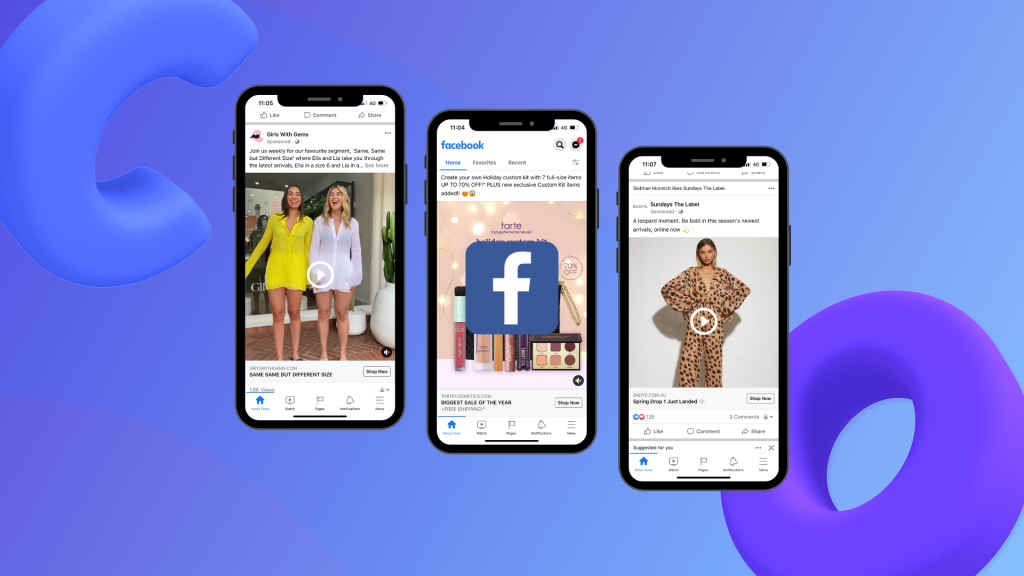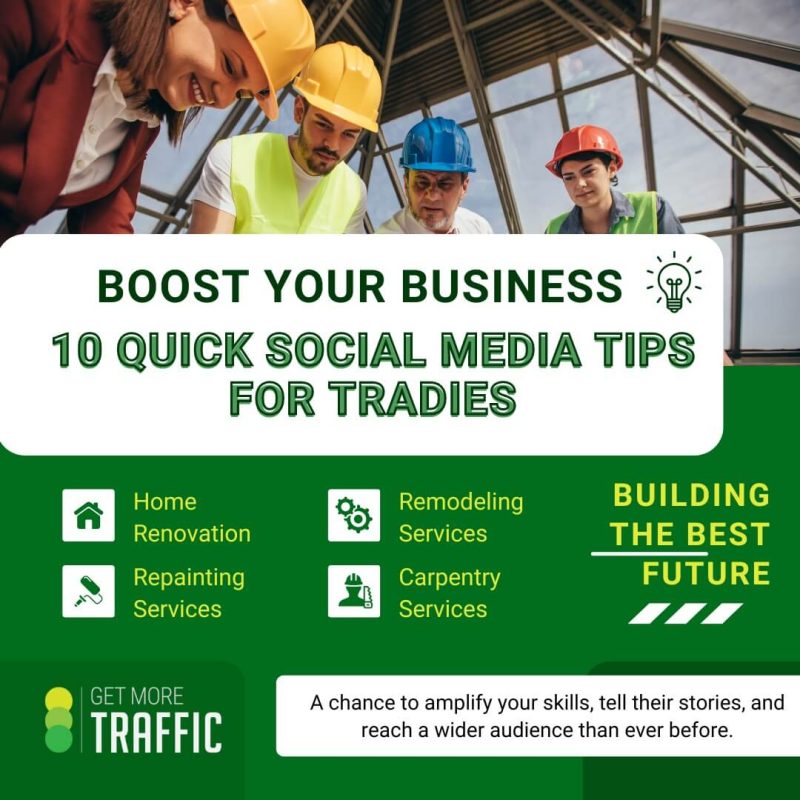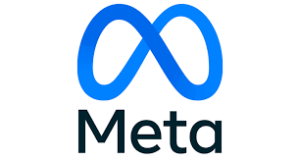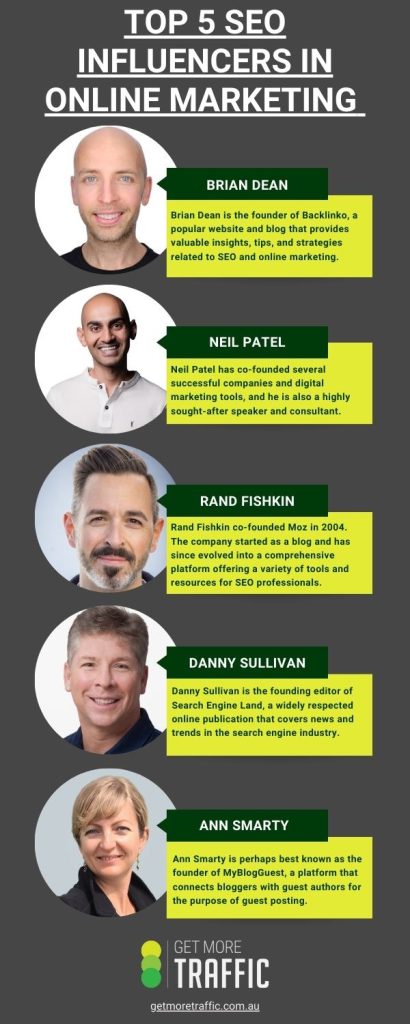What is Meta?
Meta, is a company that has redefined the way we connect, communicate, and consume content. Meta, previously known as Facebook, has expanded its horizons beyond the conventional realms of social networking and now offers a multitude of services under its umbrella. One of the standout components of this transformation is Meta Ads – a dynamic advertising platform that enables businesses to engage with their target audience like never before. Its flagship product, the Facebook social media platform, has grown to encompass a broader vision, leading to the rebranding of the company as Meta. Meta envisions a metaverse that goes beyond traditional digital experiences, integrating augmented reality, virtual reality, and various other technological advancements.
What are Meta Ads?
Definition
Meta Ads, an integral part of Meta’s ecosystem, are a sophisticated form of digital marketing that empowers businesses to connect with their target audience across multiple platforms, including Facebook, Instagram, Messenger, and more. These ads leverage the vast amount of data within the Meta network to deliver personalized and relevant content to users, thereby enhancing the effectiveness of marketing campaigns.
Purpose
Meta Ads serve a multifaceted purpose in the digital marketing landscape. They enable businesses to reach a wider audience by connecting people from all over the world as their potential target audience. It provides a diverse range of advertising formats like video or image which caters to various business goals and creative strategies which maximises engagement. It also helps with analysing results as it provides tools and techniques to track the performance of the campaigns in real-time, enabling data-driven optimizations.
Types of Meta Ads
Facebook Ads

They let businesses use single images to promote their products, services, or brand. Image ads can be used across different ad types, placements, and aspect ratios. Image ads are a good fit for campaigns with strong visual content that can be shown in just one image. These images could be made from illustrations, design, or photography.
Facebook lets businesses use a single video to showcase their products, services, or brand.They’re especially helpful for product demos, tutorials, and showcasing moving elements.
Carousel ads showcase up to ten images or videos that users can click through. Each has its own headline, description, or link. Carousels are a great choice for displaying a series of different products. Each image in the carousel can even have its own landing page that’s specifically built for that product or service.
Instant Experience ads, previously known as Canvas Ads, are mobile-only interactive ads that let users engage with your promoted content on Facebook. Using Instant Experience ads, users can tap through a carousel display of images, shift the screen in different directions, as well as zoom in or out of content.
Collection ads are kind of like immersive carousels — taking the user experience a step up. Collection ads are mobile window-shopping experiences where users can flick through your product lineup.
Instagram Ads

These are single-image ads that appear in users’ Instagram feeds. They are a simple yet effective way to showcase products or services and can be used to drive traffic to a website or landing page.
Video ads are similar to photo ads, but they use videos instead of images to convey the message. Instagram videos can be up to 60 minutes long, but you should prefer much shorter videos for your ad. Video ads are a great way to tell a brand story or showcase a product in action.
-
Carousel ads
Carousel ads allow businesses to showcase multiple images or videos within a single ad unit. Users can swipe through the images or videos, giving them a more immersive experience.
-
Story ads
Instagram Stories ads are full-screen ads that appear in between users’ stories. These ads are a great way to create interactive and immersive experiences for users and this is why engagement is often higher with this type of ad.
-
Collection ads
Collection ads are designed for e-commerce businesses and allow users to shop directly from within the ad. These ads feature a cover image or video and multiple product images below, making it easy for users to browse and purchase products.
-
Explore ads
Explore ads appear in the Explore section of the Instagram app, where users discover new content. These ads are a great way to reach a new audience and increase brand awareness. Instagram Explore ads do not appear directly in the Explore section, but are shown after someone clicks on a photo or video from Explore.
-
Shopping ads
Designed for e-commerce businesses that have a shop on Instagram, Shopping ads take users directly to a product description page within the app. From there, your customers can easily make a purchase.
-
Reels ads
After the launch of Reels, Instagram has also allowed Reels Ads. These ads are usually videos, up to 60 seconds long, that are shown between Reels.
Process
Step 1. Choose your objective
Login into Facebook Ads Manager and select the Campaign tab, then click Create to get started with a new Facebook ad campaign. There are 3 marketing categories – Awareness, Consideration and Conversion that Facebook provides with consumers on what they want their ad to accomplish.
Step 2. Name your campaign
Name your Facebook ad campaign and declare whether your ad fits into any special categories like credit or politics. If you want to set up an A/B split test, click Get Started in the A/B Test section to set this ad as your control. You can choose different versions to run against this ad after it’s published. Scroll down a little further to choose whether to turn on Advantage Campaign Budget+. This option can be useful if you’re using multiple ad sets, but for now, you can leave it turned off. Click Next.
Step 3. Set your budget and schedule
At the top of this screen, you will name your ad set and choose which Page to promote. Next, you decide how much money you want to spend on your Facebook ad campaign. You can choose a daily or lifetime budget. Then, set the start and end dates if you want to schedule your ad in the future or choose to make it live right away.
Step 4. Target your audience
Scroll down to start building the target audience for your ads. Start by selecting your target location, age, gender and language. Under location, you can even choose to include or exclude cities over a certain size. You can also prioritize people who’ve recently shown an interest in the product or service you sell.
Step 5. Choose your Facebook Placements
Scroll down to choose where your ads will appear. If you’re new to Facebook advertising, the simplest choice is to use Advantage+ Placements. When you select this option, Facebook will automatically place your ads across Facebook, Instagram, Messenger, and the Audience Network when they are likely to get the best results
Step 6. Set brand safety and cost controls
Scroll down to the Brand Safety section to exclude any types of content that would be inappropriate to appear with your ad.
Step 7. Create your ad
First, choose your ad format, then enter the text and media components for your ad. The formats available will vary based on the campaign objective you selected back at the beginning of this process. Use the preview tool at the right of the page to make sure your ad looks good for all potential placements. When you’re happy with your choices, click the green Publish button to launch your ad.

Tips and Tricks
- Use vertical videos: Use a vertical or square aspect ratio. Most people hold their phones vertically, so you’ll cover more of their screen.
- Shorten text: People on Facebook and Instagram scan quickly. In research conducted by the Mobile Marketing Association, it took two to three seconds for two out of three for people to see and cognitively recognise desktop ads compared to 0.4 seconds on mobile. Keep your text short, clear and concise to get your message across.
- Add multiple images using the carousel format: Carousel allows you to show several images for people to scroll through at the same cost. It’s a great opportunity if you have lots of product or brand images.
- Add movement: Ads with movement can stand out in Feed. Templates in Meta Ads Manager can help you create a video ad from your images.
- Use calls to action: A range of call-to-action (CTA) buttons are available for Facebook and Instagram ads. These buttons draw attention and encourage people to engage with your ad. Based on what you want people to do when they see your ad, experiment with the CTA buttons available for different ad objectives and formats. See which ones get your audience to take action.
Resources
Paid Meta Training Resources
Free Meta Training Resources
YouTube is not only a platform for sharing videos but also a powerful advertising tool that allows businesses to reach a global audience in creative and engaging ways. Understanding the various YouTube ad formats is crucial for creating successful ad campaigns that resonate with your target audience. In this comprehensive guide, we will explore the different YouTube ad formats, their features, benefits, and when to use each format effectively.

Exploring the differences of YouTube Ad Formats:
Skippable Ads

Best for: Maximizing Brand Exposure
Skippable ads, also known as TrueView in-stream ads, are one of the most common ad formats on YouTube. These ads appear before, during, or after a user’s chosen video and can be skipped after the first 5 seconds. The key features include:
- Ad Length: Skippable ads can vary in length, but the first 5 seconds are crucial for capturing viewers’ attention
- Engagement: Viewers can skip the ad after 5 seconds, so creating a compelling hook in the beginning is essential
- Cost: Advertisers are charged when viewers watch at least 30 seconds of the ad of the entire ad if it’s shorter than 30 seconds
Non- Skippable Ads

Best for: Conveying Important Messages
Non-skippable ads are short video ads that viewers are required to watch before they can access their chosen video content. These ads are limited to 15 seconds in most cases. Key features include:
- Viewing Obligation: Viewers must watch the entire ad, which can lead to higher engagement
- Message Efficiency: Due to the time constraint, these ads require clear and concise messaging
- User Experience: While they ensure ad views, non-skippable ads can be seen as intrusive if not well-crafted
Bumper Ads

Best for: Delivering A Punchy Message
Bumper ads are short, non-skippable video ads that are limited to 6 seconds. These ads are designed to be concise and impactful, making them ideal for mobile users. Key features include:
- Limited Length: The 6-second limit encourages advertisers to convey their message quickly and creatively
- Mobile-Friendly: Bumper ads are effective on mobile devices, where attention spans are typically shorter
- Frequency: They can be used as a supplement to longer ads to reinforce your message
Overlay Ads

Best for: Prompting a call to action (CTA)
Overlay ads, also known as display ads, appear as banner ads at the bottom of the video player. They can be text-based or rich media ads. Key features include:
- Visual Presence: Overlay ads don’t interrupt the video content and are displayed as a semi-transparent overlay
- Engagement: They encourage viewers to click through to your website or landing page
- CTR Tracking: Overlay ads’ click-through rates (CTR) can help measure their effectiveness
Sponsored Cards

Best for: Showcasing products
Sponsored cards are interactive, content-specific cards that promote products featured within the video or related products. They appear as small teasers within the video. Key features include:
- Contextual: Sponsored cards provide relevant information about the products or services featured in the video
- Interactivity: Viewers can click on the card to see mobile details or visit the advertiser’s website
- Engagement: These cards enhance the user experience by offering additional value
Discovery Ads

Best for: Capturing Intentful Viewers
Discovery ads, previously known ad TrueView discovery ads, are promoted videos that appear in YouTube search results, alongside related videos, and on the YouTube mobile homepage: Key features include:
- Placement: Discovery ads are strategically placed in areas where users are actively looking for content
- Viewer Intent: These ads target users who are more likely to engage due to their search or browsing behaviour
- Thumbnail and Title: The ad’s success depends on an attention-grabbing thumbnail and an enticing title
Masthead Ads

Best for: Broad Audience Impact
Masthead Ads, also known as YouTube’s “Masthead” placement, allow your video to take center stage at the top of YouTube’s homepage on all devices, from desktops to mobile devices and smart TVs. The prime real estate grants you unparalleled visibility and exposure, making it an ideal choice for campaigns aimed at maximum reach and brand impact. Key features include:
- Massive Reach: Engaging a diverse audience with prime placement, ensure that your message reaches users across various demographics and interests
- Visual impact: Capture attention instantly with autoplay visuals
- Clickable CTAs: Direct traffic with overlay CTSs for seamless engagement
10 Steps to Start YouTube Ads

Starting YouTube ads involves careful planning and execution, but the potential to reach a massive and engaged audience makes it worthwhile. By following these 10 steps, you will be on your way to create impactful and successful YouTube ad campaigns that drive your marketing objectives.
1.Define Goals:
Clarify your campaign objectives. Are you aiming for brand exposure, website traffic, lead generation, or sales conversions? Having clear goals will shape your entire strategy
2. Create Channel:
Establish a YouTube channel for your business. This provides a dedicated space to host your video content and manage your advertising campaigns
3. Link Accounts:
Link your YouTube channel to a Google Ads account. This integration allows you to manage and track your ad campaign seamlessly
4. Budget:
Determine your budget for the campaign. Decide whether you want to allocate a specific amount per data or for the entire campaign duration. Google Ads offers various budgeting options to suit your needs.’
5. Audience:
Identifying your target audience. Consider demographics like age, gender, location, and interests. The more precise your audience targeting, the higher the chances of reaching the right viewers
6. Choose Format:
Select the appropriate ad format based on your goals. For instance, if you want to create brand awareness, skippable ads might be ideal. If you have a short, impactful message, bumper ads could work better
7. Craft Content:
Develop compelling video content that resonates with your audience. Start with a captivating hook in the opening seconds to capture viewers’ attention and encourage them to watch further
8. Set tracking:
Implement tracking mechanisms, such as Google Analytics or conversion tracking, to measure the effectiveness of your campaign. This data helps you refine your strategy and understand what’s working
9. Campaign Details:
Configure campaign parameters. Specify the campaign start and end dates, ad scheduling (when your ads will run), and geographic targeting (where your ads will be shown)
10. Launch and Optimize:
Review your campaign settings, content, and targeting one final time. Once you are satisfied, launch the campaign. Continuously monitor key performance indicators (KPIs) like click-through rates, view rates, and conversions. Use these insights to optimize your ads for better results over time
As you navigate the world of YouTube advertising, understanding these various ad formats is essential for tailoring your campaigns to your audience’s preferences and behavious. Each format offers unique advantages, and by strategically using them, you can create compelling and experiences that resonate with viewers and drive your marketing goals.
The key to a successful YouTube ad campaign is not only choosing the right format but also crafting engaging content that captures your audience’s attention and encourages them to take action.
Boost Your Business: 10 Quick Social Media Tips for Tradies
Quick Social Media Tips for Tradies
In this modern world, social media has become more than just a way to connect; it’s a powerful tool that can transform businesses and careers. For tradies, harnessing the potential of social media marketing is a game-changer. It means to showcase their craftsmanship, engage with clients, and take their businesses to the next level.
Platforms like Facebook, Instagram, and LinkedIn offer tradies the chance to amplify their skills, tell their stories, and reach a wider audience than ever before. With every post, image, and interaction, tradies can build a brand that stands out and creates lasting impressions.
This guide delves into the essentials of social media marketing for tradies. From choosing the right platforms to crafting compelling content, we’ll navigate the landscape together. Whether you are a seasoned pro looking to expand your reach or a newcomer ready to make a mart, this guide is your roadmap to leveraging social media for your tradie business.

1. Choose the Right Platforms
Focus on platforms that align with your target audience. Selecting the most suitable platforms is a critical step. Not all platforms are created equal, and different platforms attract different demographics and user behaviours. The choice of platforms should align with your target audience and the nature of your trade. Facebook, Instagram, and LinkedIn are popular choices. Instagram is great for visual content, while LinkedIn can be useful for connecting with other professionals and businesses.
2. Optimise Your Profiles
Optimising your profiles is a crucial step in making a strong first impression and establishing credibility on social media platforms. Ensure your profiles are complete, consistent, and professional. Use high-quality profile and cover images, and write a clear and concise bio that highlights your services and expertise. Your platforms serve as the digital storefront for your tradie business, and they should reflect professionalism, expertise, and a clear representation of your services. Some key elements to be focused on include:
- Profile and Cover Images
- Bio and About Section
- Contact information
- Visual elements
- Call to Action (CTA)
4. Showcase Your Work

Visual content is a powerful tool especially for tradies to demonstrate their expertise, creativity, and the transformative impact of their work. When potential clients can see the tangible results you can deliver, it builds trust and excitement. Here is how you can effectively showcase your work:
- Before-and-After Stories:
- Visual transformation: Capture the dramatic change your work brings by posting before-and-after photos. The visual storytelling provides a clear and compelling narrative of your skills
- High-Quality Imagery:
- Attention to Detail: Ensure that the images you share are of high quality, well-lit, and showcase the finer details of your work. Crisp visuals reflect professionalism and attention to detail
- Project Progress Updates:
- Step-by-Step Journey: Use platforms like Instagram to share the progression of your projects. Carousel posts allow you to showcase a series of images, demonstrating the various stages of your work
- Project Descriptions:
- Highlight Key Details: Alongside your images, provide brief descriptions of the projects. Include information like project type, materials used, and any unique aspects that set it apart
- Client testimonials:
- Social Proof: Share testimonials from satisfied clients alongside images of their projects. This combination of visuals and positive feedback strengthens your credibility
4. Engage Authentically
Engaging with your audience authentically is a cornerstone of effective social media marketing. It is not just about broadcasting your message; it is about building relationships, nurturing connections, and establishing your brand as approachable and reliable. By engaging authentically, you foster a sense of connection and community, transforming casual viewers into dedicated followers and potential clients into loyal customers. Genuine interactions leave a lasting impression, contributing to the growth and success of your tradie business.
5. Use Relevant Hashtags
Research and use industry-related and location-specific hashtags to increase the visibility of your posts. Hashtags are like signposts that help users discover content related to specific topics or themes. For tradies, using relevant hashtags strategically can significantly boost the visibility of your posts and attract the attention of potential clients who are searching for services in your industry. Hashtags that are relevant to you include:
- Trending Hashtags – keep an eye on trending hashtags related to your trade
- Platform-Specific Tags – Utilize platform features
- A Branded Hashtag – create a unique hashtag that represents your business
- Local Discovery – Connect with your local community, build a reputation as a trusted trade in your area
6. Educational Content
Educational content is a valuable way to position yourself as an expert in your field and provide real value to your audience. Share informative content related to your field. By sharing tips, how-to guides, and industry insights, you not only demonstrate your expertise but also foster a sense of trust and credibility. Here is how you can effectively create and share educational content:
- Identify Your Audience’s Needs:
- Understand Pain Points and consider the common challenges, questions, and concerns that your clients and potential clients have
- Clear and Concise Content:
- Simplify Complex Concepts by breaking down complex ideas into simple and understandable terms. Use clear language and step-by-step explanations
- Step-by-Step Guides:
- Crafting step-by-step guides for common DIY tasks or maintenance routines
- Industry Insights:
- Stay current and share updates about industry trends, innovations, and news
- Address FAQs:
- Compile a list of frequently asked questions from clients and address them in your content to help preempt doubts and provides quick solutions
7. Customer Testimonials
To build trust and credibility, customer testimonials are a powerful form of social proof that can significantly influence potential clients’ perceptions of your tradie business. By showcasing genuine customer testimonials, you can build a narrative of satisfied clients who have benefited from your services. This form of social proof can be a decisive factor for potential clients considering whether to choose your tradie business.
8. Behind-the-Scenes Content

Behind-the-scenes content humanized your brand, offering a glimpse into the people, processes, and stories that drive your tradie business. It adds a personal touch to your online presence, fostering a sense of connection and relatability with your audience. Some behind-the-scenes content include documenting day-to-day activities, highlighting team members, project evolution, problem-solving moments, introducing tools and techniques, showcase craftsmanship, and celebrations and milestones and more.
9. Analytics and Insights
Analytics and insights are valuable tools that provide you with data-driven insights into how your content is performing on social media platforms. By understanding what’s working and what’s not, you can make informed decisions to optimize your strategy for better results. Use the built-in analytics tools on each platform to track the performance of your posts and campaigns. You are able to tailor your content, posting schedule, and overall strategy to match your audience’s preferences and behaviors. Regularly monitoring and analyzing your analytics empowers you to make data-driven decisions that yield more effective results over time.
10. Paid Advertising
Paid advertising on social media offers a powerful way to expand your reach, target specific demographics, and promote your tradie services to a larger audience. Platforms like Facebook, Instagram, and others provide sophisticated tools for precise ad targeting, making your campaigns more effective.It also allows you to tap into the platforms’ extensive user base and finely tune your campaigns to reach the right people at the right time. It is a dynamic tool that can yield impressive results and contribute to the growth of your tradie business.

In conclusion, social media marketing presents a remarkable opportunity for tradies to amplify their businesses, connect with potential clients and establish themselves as trusted experts in their fields. By implementing these strategies, tradies can cultivate a strong online presence, connect with their desired audience, and ultimately drive business growth.
Boost Your Business: 10 Quick Social Media Tips for Tradies
Quick Social Media Tips for Tradies
In this modern world, social media has become more than just a way to connect; it’s a powerful tool that can transform businesses and careers. For tradies, harnessing the potential of social media marketing is a game-changer. It means to showcase their craftsmanship, engage with clients, and take their businesses to the next level.
Platforms like Facebook, Instagram, and LinkedIn offer tradies the chance to amplify their skills, tell their stories, and reach a wider audience than ever before. With every post, image, and interaction, tradies can build a brand that stands out and creates lasting impressions.
This guide delves into the essentials of social media marketing for tradies. From choosing the right platforms to crafting compelling content, we’ll navigate the landscape together. Whether you are a seasoned pro looking to expand your reach or a newcomer ready to make a mart, this guide is your roadmap to leveraging social media for your tradie business.

1. Choose the Right Platforms
Focus on platforms that align with your target audience. Selecting the most suitable platforms is a critical step. Not all platforms are created equal, and different platforms attract different demographics and user behaviours. The choice of platforms should align with your target audience and the nature of your trade. Facebook, Instagram, and LinkedIn are popular choices. Instagram is great for visual content, while LinkedIn can be useful for connecting with other professionals and businesses.
2. Optimise Your Profiles
Optimising your profiles is a crucial step in making a strong first impression and establishing credibility on social media platforms. Ensure your profiles are complete, consistent, and professional. Use high-quality profile and cover images, and write a clear and concise bio that highlights your services and expertise. Your platforms serve as the digital storefront for your tradie business, and they should reflect professionalism, expertise, and a clear representation of your services. Some key elements to be focused on include:
- Profile and Cover Images
- Bio and About Section
- Contact information
- Visual elements
- Call to Action (CTA)
4. Showcase Your Work

Visual content is a powerful tool especially for tradies to demonstrate their expertise, creativity, and the transformative impact of their work. When potential clients can see the tangible results you can deliver, it builds trust and excitement. Here is how you can effectively showcase your work:
- Before-and-After Stories:
- Visual transformation: Capture the dramatic change your work brings by posting before-and-after photos. The visual storytelling provides a clear and compelling narrative of your skills
- High-Quality Imagery:
- Attention to Detail: Ensure that the images you share are of high quality, well-lit, and showcase the finer details of your work. Crisp visuals reflect professionalism and attention to detail
- Project Progress Updates:
- Step-by-Step Journey: Use platforms like Instagram to share the progression of your projects. Carousel posts allow you to showcase a series of images, demonstrating the various stages of your work
- Project Descriptions:
- Highlight Key Details: Alongside your images, provide brief descriptions of the projects. Include information like project type, materials used, and any unique aspects that set it apart
- Client testimonials:
- Social Proof: Share testimonials from satisfied clients alongside images of their projects. This combination of visuals and positive feedback strengthens your credibility
4. Engage Authentically
Engaging with your audience authentically is a cornerstone of effective social media marketing. It is not just about broadcasting your message; it is about building relationships, nurturing connections, and establishing your brand as approachable and reliable. By engaging authentically, you foster a sense of connection and community, transforming casual viewers into dedicated followers and potential clients into loyal customers. Genuine interactions leave a lasting impression, contributing to the growth and success of your tradie business.
5. Use Relevant Hashtags
Research and use industry-related and location-specific hashtags to increase the visibility of your posts. Hashtags are like signposts that help users discover content related to specific topics or themes. For tradies, using relevant hashtags strategically can significantly boost the visibility of your posts and attract the attention of potential clients who are searching for services in your industry. Hashtags that are relevant to you include:
- Trending Hashtags – keep an eye on trending hashtags related to your trade
- Platform-Specific Tags – Utilize platform features
- A Branded Hashtag – create a unique hashtag that represents your business
- Local Discovery – Connect with your local community, build a reputation as a trusted trade in your area
6. Educational Content
Educational content is a valuable way to position yourself as an expert in your field and provide real value to your audience. Share informative content related to your field. By sharing tips, how-to guides, and industry insights, you not only demonstrate your expertise but also foster a sense of trust and credibility. Here is how you can effectively create and share educational content:
- Identify Your Audience’s Needs:
- Understand Pain Points and consider the common challenges, questions, and concerns that your clients and potential clients have
- Clear and Concise Content:
- Simplify Complex Concepts by breaking down complex ideas into simple and understandable terms. Use clear language and step-by-step explanations
- Step-by-Step Guides:
- Crafting step-by-step guides for common DIY tasks or maintenance routines
- Industry Insights:
- Stay current and share updates about industry trends, innovations, and news
- Address FAQs:
- Compile a list of frequently asked questions from clients and address them in your content to help preempt doubts and provides quick solutions
7. Customer Testimonials
To build trust and credibility, customer testimonials are a powerful form of social proof that can significantly influence potential clients’ perceptions of your tradie business. By showcasing genuine customer testimonials, you can build a narrative of satisfied clients who have benefited from your services. This form of social proof can be a decisive factor for potential clients considering whether to choose your tradie business.
8. Behind-the-Scenes Content

Behind-the-scenes content humanized your brand, offering a glimpse into the people, processes, and stories that drive your tradie business. It adds a personal touch to your online presence, fostering a sense of connection and relatability with your audience. Some behind-the-scenes content include documenting day-to-day activities, highlighting team members, project evolution, problem-solving moments, introducing tools and techniques, showcase craftsmanship, and celebrations and milestones and more.
9. Analytics and Insights
Analytics and insights are valuable tools that provide you with data-driven insights into how your content is performing on social media platforms. By understanding what’s working and what’s not, you can make informed decisions to optimize your strategy for better results. Use the built-in analytics tools on each platform to track the performance of your posts and campaigns. You are able to tailor your content, posting schedule, and overall strategy to match your audience’s preferences and behaviors. Regularly monitoring and analyzing your analytics empowers you to make data-driven decisions that yield more effective results over time.
10. Paid Advertising
Paid advertising on social media offers a powerful way to expand your reach, target specific demographics, and promote your tradie services to a larger audience. Platforms like Facebook, Instagram, and others provide sophisticated tools for precise ad targeting, making your campaigns more effective.It also allows you to tap into the platforms’ extensive user base and finely tune your campaigns to reach the right people at the right time. It is a dynamic tool that can yield impressive results and contribute to the growth of your tradie business.

In conclusion, social media marketing presents a remarkable opportunity for tradies to amplify their businesses, connect with potential clients and establish themselves as trusted experts in their fields. By implementing these strategies, tradies can cultivate a strong online presence, connect with their desired audience, and ultimately drive business growth.
Top Five SEO Influencers in 2023
As businesses strive to enhance their digital presence and climb the ranks of search engine results, the guidance and expertise of SEO influencers have become invaluable. In this article, we delve into the realm of online marketing to present you with a curated list of the top five SEO influencers who are shaping the way we understand and implement SEO strategies. From thought-provoking insights to innovative techniques, these influencers have earned their place at the forefront of the SEO sphere, providing actionable advice that can transform your digital endeavors.
1. Brian Dean
Brian Dean is the founder of Backlinko, a popular website and blog that provides valuable insights, tips, and strategies related to SEO and online marketing. He gained a significant following by sharing in-depth and actionable guides on topics such as link building, on-page SEO, content creation, and more.
One of Brian Dean’s most famous concepts is the “Skyscraper Technique,” a content creation and link-building strategy that involves finding existing popular content, creating something even better, and then reaching out to relevant websites to gain backlinks. This technique has been widely adopted by marketers and SEO professionals as an effective way to improve a website’s search engine rankings.
Brian Dean Profiles:
Brian Dean Courses:
2. Neil Patel
Neil Patel has co-founded several successful companies and digital marketing tools, and he is also a highly sought-after speaker and consultant. He has co-founded companies like Crazy Egg, Hello Bar, and Kissmetrics, which offer various analytics and conversion optimization tools for websites. These tools have been used by many businesses to improve their online presence and user experience. He is known for creating extensive and informative content on his blog and YouTube channel. His content aims to help both beginners and experienced marketers understand and implement effective online marketing strategies.
Neil Patel Profiles:
Neil Patel Courses:
3. Rand Fishkin
Rand Fishkin co-founded Moz in 2004. The company started as a blog and has since evolved into a comprehensive platform offering a variety of tools and resources for SEO professionals, marketers, and website owners. After leaving Moz, Rand Fishkin co-founded SparkToro, a company that provides audience intelligence tools. SparkToro helps marketers and businesses understand their target audiences better, discover where they hang out online, and make data-informed decisions about marketing strategies.
Rand Fishkin Profiles:
Rand Fishkin Courses:
4. Danny Sullivan
Danny Sullivan is the founding editor of Search Engine Land, a widely respected online publication that covers news, trends, and developments in the search engine industry. Search Engine Land provides valuable insights and updates related to search engine algorithms, search marketing, SEO, and paid search advertising. Before founding Search Engine Land, Danny Sullivan was involved with other prominent publications and events in the search industry. He was a co-founder of Search Engine Watch and was closely associated with the Search Engine Strategies (SES) conference series.
Danny Sullivan Profiles:
Danny Sullivan Courses:
5. Ann Smarty
Ann Smarty is perhaps best known as the founder of MyBlogGuest, a platform that connects bloggers with guest authors for the purpose of guest posting. Guest posting is a common practice in SEO where writers contribute content to other websites in exchange for exposure and backlinks. MyBlogGuest aimed to facilitate this process and help bloggers connect for mutual benefit. She also worked as the Content Director at Internet Marketing Ninjas (now known as NinjaCat), an online marketing agency. In this role, she contributed to the agency’s content marketing efforts and provided valuable insights to clients.
Ann Smarty Author Profiles:
Ann Smarty Courses:
Infographics:
Instagram vs. TikTok: Which Platform Is Right for Your Brand?
Social media has become an integral part of any brand’s marketing strategy, and Instagram and TikTok have emerged as two major players in the social media landscape. Both platforms offer unique opportunities to connect with audiences and promote products or services. However, choosing the right platform for your brand requires understanding their differences, target demographics, and content formats.
In this article, we will compare Instagram and TikTok, helping you make an informed decision on which platform aligns best with your brand’s marketing goals.
1. User Demographics:
User demographics refer to the characteristics and traits of a specific group of individuals who use a particular product, service, or platform. In the context of social media marketing, user demographics include factors such as age, gender, location, education level, income, interests, and behaviors. Understanding user demographics is crucial for businesses and marketers to tailor their marketing strategies and content to better reach and engage their target audience. Understand Instagram and TikTok’s audience and niche communities below:
Instagram User Demographics
- Age:
- Particularly among younger users, especially those aged between 18 and 34 years old, with an increasing number of users aged 35 and above
- Gender:
- Slightly higher percentage of female users
- Interests: Often interested in fashion, travel, food, lifestyle, fitness and photography
TikTok User Demographics
- Age:
- Majority of users falling between the ages of 16 and 24
- Reach Gen Z and younger Millennial consumers
- Gender:
- Relatively balanced gender distribution, attracting both male and female users
- Interests:
- Creatine and entertaining content, including dance challenges, lip-syncing, comedy skits, and educational videos
2. Content Formats:
In social media marketing, content formatting refers to the process of structuring and presenting content in a way that optimizes its visual appeal, readability, and engagement on social media platforms. Effective content formatting enhances the chances of capturing the audience’s attention, conveying the intended message, and encouraging them to take action. Proper content formatting is essential because social media platforms have limited space and user attention spans, making it crucial to make content visually appealing and easy to consume. Here are some key aspects of content formatting in social media marketing between Instagram and TikTok:
Instagram Content Formats:
- Photo-sharing platform, and images are a fundamental content format
- Showcase products, behind-the-scenes glimpses, lifestyle shots, and visually appealing content to capture users’ attention
- Various video lengths, ranging from short stories (15 seconds) to regular posts (up to 1 minute) and IGTV (longer-form videos up to 15 minutes)
- Use Stories to share time-sensitive content, behind-the-scenes footage, polls, Q&A sessions, and interactive stickers like quizzes and countdowns
- Carousels posts allow brands to share multiple images or videos in a single post, which users can swipe through
TikTok Content Formats:
- Primary content format consists of short videos, often set to music or audio clips
- Create entertaining, informative, or humorous videos to showcase products, share tips, participate in challenges, and engage with their audience
- Allows users to interact with content using duets and stitches to create videos alongside existing content, fostering collaboration and interaction
- Known for viral trends and challenges
- Seek educational content, such as DIY tutorials, cooking recipes, and life hacks
- Use live streaming for Q&A sessions, product launches, behind-the-scenes moments, and interactive events
3. Engagement and Reach:
Engagement refers to the level of interaction and interaction your content receives from your audience. It encompasses actions such as likes, comments, shares, saves, and clicks on your posts. High engagement indicates that your content is compelling, relevant, and valuable to your followers. It also signals to social media algorithms that your content is worth promoting, which can boost its visibility and reach.
Reach refers to the number of unique users who see your content. It is an essential metric as it measures the potential size of your audience. A higher reach means your content is being seen by more people, increasing brand visibility and awareness. Reach can be organic, where users discover your content through their feeds, or paid, through social media advertising.
To Improve Engagement:
- Create Compelling Content: Craft visually appealing, informative, and entertaining content that aligns with your audience’s interests and preferences.
- Encourage Interactivity: Use engaging captions and ask questions to prompt discussions. Encourage followers to share their opinions and experiences.
- Respond to Comments: Engage with your audience by responding to comments and messages promptly. Building a two-way conversation fosters a sense of community.
- Host Giveaways and Contests: Organize giveaways and contests to incentivize audience participation and increase engagement.
- Leverage User-Generated Content (UGC): Encourage your followers to create and share content related to your brand, showcasing their positive experiences.
To Improve Reach:
- Use Relevant Hashtags: Research and include relevant hashtags in your posts to improve discoverability and reach a broader audience.
- Optimize Posting Times: Determine the best times to post based on your audience’s active hours to ensure your content reaches more users.
- Collaborate with Influencers: Partner with influencers whose followers match your target audience, expanding your content’s reach to their networks.
- Utilize Social Media Advertising: Invest in paid advertising to reach a targeted audience beyond your current followers.
- Participate in Trending Topics: Engage with trending topics and hashtags to boost the visibility of your content among users following popular trends.
4. Influencer Marketing:
Influencer marketing has become a powerful and popular strategy for brands to reach their target audiences and promote their products or services. It involves partnering with individuals who have a significant following and influence within a specific niche or industry, known as influencers, to create and share branded content. These influencers have built a loyal and engaged audience, which brands can leverage to gain credibility, trust, and visibility.
Types of Influencers:
- Mega-Influencers: These are celebrities, athletes, or public figures with millions of followers. They have the broadest reach but may come with higher costs for collaborations.
- Macro-Influencers: Macro-influencers typically have a substantial following, often ranging from hundreds of thousands to a few million followers. They may have a more focused niche compared to mega-influencers.
- Micro-Influencers: Micro-influencers have smaller but highly engaged audiences, typically ranging from a few thousand to tens of thousands of followers. They often focus on specific niches, making them ideal for targeted marketing.
- Nano-Influencers: Nano-influencers have the smallest following, usually in the range of a few hundred to a few thousand followers. They have strong community connections and are highly trusted by their followers.
5. Hashtags and Trends:
Hashtags and trends are essential elements in social media marketing, helping brands increase visibility, engagement, and reach on various platforms.
Hashtags:
Hashtags are words or phrases preceded by the “#” symbol used to categorize content and make it discoverable to a broader audience. When users click on or search for a specific hashtag, they can find all the posts that include that tag. Here’s how hashtags can benefit your social media marketing efforts:
Trends:
Trends refer to popular topics, challenges, or discussions that gain significant traction and engagement on social media. Participating in trends can have several benefits for social media marketing:
6. Advertising Opportunities:
Advertising opportunities on social media platforms provide brands with powerful tools to reach their target audiences, increase brand visibility, and drive specific marketing objectives. Each social media platform offers a range of advertising options and formats that can be tailored to suit different campaign goals. In terms of Instagram and TikTok Advertising:
Instagram Advertising:
- Owned by Facebook, Instagram offers several advertising options, including photo ads, video ads, carousel ads, and Stories ads.
- Instagram’s visually-driven platform is ideal for brands with compelling visual content and products.
- Brands can target specific demographics and interests, and leverage Facebook’s targeting capabilities for Instagram ads as well.
TikTok Advertising:
- TikTok’s advertising options include In-Feed Ads, TopView Ads, Brand Takeovers, and Branded Hashtag Challenges.
- In-Feed Ads are short-form videos that appear in users’ “For You” feed, while TopView Ads are full-screen ads displayed when users open the app.
Key Considerations:
- Define Clear Objectives: Clearly outline your campaign goals, whether it’s increasing brand awareness, driving website traffic, generating leads, or boosting sales.
- Audience Targeting: Utilize precise targeting options offered by each platform to ensure your ads reach the right audience, increasing the likelihood of conversions.
- Ad Creativity: Create visually engaging and compelling ad content that aligns with the platform’s best practices and resonates with your target audience.
- Budget Allocation: Allocate your budget strategically across platforms and ad formats based on the effectiveness of each channel for your marketing objectives.
- Analyze and Optimize: Regularly analyze ad performance, gather insights, and optimize your campaigns to improve return on investment (ROI).
7. Brand Identity and Storytelling:
Brand identity and storytelling are crucial elements of effective marketing strategies. They go hand in hand to create a unique and compelling narrative that resonates with your audience and sets your brand apart from competitors.
Brand Identity:
Brand identity is the collection of visual and non-visual elements that represent your brand and create a consistent and recognizable image in the minds of your target audience. It encompasses the brand’s logo, colors, typography, tagline, mission, values, personality, and the overall perception it aims to convey.
Storytelling:
Storytelling is the art of conveying your brand’s message and values through compelling narratives. It allows you to engage your audience emotionally, create a personal connection, and communicate the essence of your brand effectively.
8. Analytics and Metrics:
Analytics and metrics are vital tools in social media marketing that enable brands to measure the performance and effectiveness of their campaigns. By tracking and analyzing data, businesses can make data-driven decisions, optimize their strategies, and achieve their marketing objectives.
Types of Social Media Metrics:
- Reach: The total number of unique users who have seen your content. It measures the potential size of your audience.
- Impressions: The total number of times your content has been displayed, including multiple views by the same user. It gives insights into how often your content is being shown.
- Engagement: The level of interaction your content receives, including likes, comments, shares, and clicks. High engagement indicates content relevance and resonance with your audience.
- Click-Through Rate (CTR): The percentage of users who clicked on a specific link or call-to-action (CTA) in your content, indicating interest in further engagement.
- Conversion Rate: The percentage of users who completed a specific action, such as filling out a form or making a purchase, after interacting with your content.
- Follower Growth: The rate at which your social media following is increasing over a specific period, indicating the success of your content and brand appeal.
- Engagement Rate: The percentage of followers who interact with your content (likes, comments, shares) relative to your total number of followers.
- Return on Investment (ROI): The financial return on your social media marketing efforts, calculated by comparing the revenue generated from campaigns to the cost of running those campaigns.
Social Media Analytics Tools:
- Platform Insights: Most social media platforms offer built-in analytics tools that provide valuable data on reach, engagement, impressions, and audience demographics.
- Third-Party Analytics Tools: Several third-party tools provide in-depth analytics for multiple social media platforms, allowing brands to compare performance across channels.
- UTM Parameters: UTM parameters can be added to URLs in social media posts, allowing you to track the source of traffic and conversions in Google Analytics.
- Custom Dashboards: Create customized dashboards in analytics tools to monitor and analyze specific metrics and KPIs relevant to your brand’s goals.
As social media continues to evolve, choosing between Instagram and TikTok requires a thorough understanding of your target audience, brand identity, and marketing objectives. Both platforms offer unique opportunities for engagement, brand exposure, and creativity. By considering the demographics, content formats, advertising capabilities, and analytics on each platform, your brand can make an informed decision on which social media channel is the best fit for reaching and engaging your audience effectively.
Complete Branding Guide for Tradies | Make Your Brand Professional
Understanding Branding for Tradies:
Branding for tradies refers to the strategic process of creating and managing a unique and cohesive identity for businesses and professionals in the skilled trades industry. It goes beyond just designing logos and choosing colors; instead, it involves shaping the perception of the business in the minds of potential and existing customers. Branding is a comprehensive approach that encompasses visual elements, brand messaging, customer experience, and the overall reputation of the tradie business.
What is branding for tradies and why is it important?
Branding is the sum of all the experiences, emotions, and associations that customers have with a tradie business. It represents the business’s personality, values, and promise to customers. In the trades industry, where competition can be fierce, branding becomes a vital tool for tradies to stand out from the crowd and establish a strong presence in the market.
A well-executed branding strategy can help tradies:
- Build Trust and Credibility: A consistent and professional brand image fosters trust among potential customers, as it indicates reliability and competence in delivering services.
- Attract and Retain Customers: A strong brand identity helps tradies attract new customers and also fosters loyalty among existing ones, leading to repeat business and word-of-mouth referrals.
- Command Premium Pricing: A reputable brand allows tradies to justify premium pricing for their services, as customers are willing to pay more for perceived value and quality.
- Increase Business Value: A well-established brand enhances the overall value of the tradie business, making it a valuable asset in case of future expansion or sale.
- Establish a Memorable Identity: A distinctive brand identity creates a lasting impression on customers, making it easier for them to remember and recommend the tradie’s services.
The benefits of a strong brand in the trades industry:
In the competitive trades industry, a strong brand confers several advantages to tradies
- Competitive Advantage: A well-defined brand helps tradies differentiate themselves from competitors who may offer similar services. It allows tradies to communicate their unique strengths and value propositions clearly.
- Customer Loyalty: A strong brand creates an emotional connection with customers, fostering loyalty and repeat business. Satisfied customers are more likely to choose the same tradie for future projects.
- Enhanced Professionalism: A consistent brand image signals professionalism and reliability, influencing potential customers to perceive the tradie business as more established and trustworthy.
- Confidence in Marketing: With a strong brand identity, tradies can market their services with confidence, knowing that their message is consistent and impactful.
- Business Expansion Opportunities: A reputable brand opens doors to potential partnerships, collaborations, and expansion opportunities in the industry.
Branding for Tradie Startups:
For tradie startups, branding is a critical foundation that sets the tone for their business’s growth and success. Building a strong brand identity from the beginning helps startups establish themselves in the market and create a positive first impression with customers. Startups need to invest time in understanding their target audience, industry landscape, and competitive advantages to craft a brand that resonates with their potential customers.
Branding for Existing Brands:
Established tradie businesses can benefit from branding efforts by refining their existing brand identity and staying relevant in a changing market. Rebranding or updating the brand can be a strategic move to revitalize the business, attract new customers, and reinforce their market position. Existing brands must assess their current brand perception, customer feedback, and market trends to make informed decisions about evolving their brand while maintaining brand equity.
Developing a Brand Identity:
Developing a strong brand identity is a crucial aspect of successful branding for tradies. It involves carefully crafting the visual and verbal elements that will represent the essence of the business and resonate with the target audience. A well-defined brand identity not only sets the tradie business apart from competitors but also communicates its values, personality, and professionalism. Here’s an expanded explanation of the key components involved in developing a brand identity:
Creating a Unique Brand Name and Logo:
The brand name is the foundation of the tradie’s identity. It should be distinctive, memorable, and relevant to the business. When choosing a brand name, tradies should consider factors like simplicity, availability of domain names, and potential trademark conflicts. A well-thought-out logo, on the other hand, visually symbolizes the brand and serves as its recognizable face. The logo should be designed to reflect the nature of the business and leave a lasting impression on customers.
Choosing Brand Colors and Typography:
Colors play a significant role in brand identity, as they evoke emotions and associations. Tradies should carefully select a color palette that aligns with their brand personality and appeals to their target audience. For example, bold and vibrant colors might be suitable for a construction company, while softer and earthy tones could work well for a landscaping business. Typography, the choice of fonts and how they are used, also contributes to the overall brand aesthetics and should be consistent with the brand’s style.
Crafting a Brand Tagline or Slogan:
A brand tagline or slogan is a short and memorable phrase that encapsulates the essence of the tradie business. It should convey the unique value proposition, core message, or mission of the brand in a concise and impactful way. A well-crafted tagline can become a powerful tool in reinforcing the brand’s identity and leaving a lasting impression on customers. For instance, a plumbing business might use a tagline like “Your Pipes, Our Expertise,” emphasizing their commitment to providing top-notch plumbing services.
The process of developing a brand identity requires careful research and understanding of the target market, competition, and the unique strengths of the tradie business. It is essential to maintain consistency across all brand elements to ensure a cohesive and recognizable brand presence. Once the brand identity is established, it can be applied to various aspects of the business, including marketing materials, website design, uniforms, and even the appearance of company vehicles. A strong and consistent brand identity builds trust and credibility with customers, making them more likely to choose the tradie’s services over others in the market.
Defining Your Brand Personality:
Identifying and defining your brand’s personality traits:
Tradies need to identify the personality traits that best represent their brand. This involves understanding the core values of the business, its mission, and what it wants to be known for in the market. Some common brand personality traits include:
- Reliable: Emphasizing consistency and dependability in delivering high-quality services.
- Friendly: Portraying approachability and warmth in customer interactions.
- Professional: Conveying expertise and competence in the trade industry.
- Innovative: Highlighting a forward-thinking and creative approach to problem-solving.
- Trustworthy: Building trust and credibility by being honest and transparent with customers.
Aligning the brand personality with the target audience:
To create a strong brand connection, tradies must understand their target audience’s preferences, needs, and values. By aligning the brand personality with the target audience, the brand becomes more appealing and relatable.
Here are some steps defining your brand personality:
- Determine your brand’s target audience
- Identify your brand archetype mix
- Identify your brand’s values
- Define your brand’s voice
- Create a visual identity
- Communicate consistently
Adding to this, Market research and customer feedback play a crucial role in gaining insights into the target audience’s perceptions and expectations. With a deep understanding of the audience, tradies can tailor their brand messaging and communication to resonate with potential customers.
Maintaining consistency in brand messaging:
Consistency is key to establishing a strong brand personality. Tradies must ensure that the brand’s personality traits are consistently communicated across all brand touchpoints, including marketing materials, website, social media, and customer interactions. Inconsistent messaging can confuse customers and dilute the brand’s identity.
Brand guidelines can help maintain consistency by providing clear instructions on how to use brand elements, colors, and language. These guidelines should be followed by all team members and stakeholders involved in representing the brand. Consistency in brand messaging reinforces the brand’s personality, making it easier for customers to recognize and connect with the brand across various platforms.
Brand Messaging and Communication:
Crafting a compelling brand story:
A brand story is a narrative that communicates the tradie business’s history, mission, values, and journey. It humanizes the brand, making it more relatable to customers. The brand story should be authentic, engaging, and emotionally compelling. It can include the challenges the tradie business overcame, its passion for the trade, and the positive impact it seeks to create for its customers. A well-crafted brand story helps customers connect with the brand on a deeper level and understand the purpose behind the tradie business.
Developing key brand messages and value propositions:
Key brand messages are the core statements and phrases that succinctly communicate the brand’s unique selling points and benefits to the customers. These messages should be clear, concise, and tailored to the needs and pain points of the target audience. Value propositions are statements that explain the value customers can expect to receive from the tradie’s services. They emphasize the benefits, quality, and advantages that set the business apart from competitors. Strong and compelling brand messages and value propositions help differentiate the tradie business and leave a lasting impression on customers.
Effective communication channels for tradies’ branding:
- Social media platforms: Social media platforms like Facebook ads and Google Ads offer opportunities to engage with the target audience, share brand stories, showcase projects, and respond to customer inquiries.
- Email Marketing and Newsletter Campaigns: Building an email list allows tradies to communicate directly with their audience, share updates, promotions, and valuable content.
- Content Marketing Strategies: Content marketing allows tradies to showcase their expertise and build trust with their audience. We’ll discuss the importance of creating valuable and informative content and strategies for content creation and distribution.
- Online Reviews and Reputation Management: This will explore the significance of online reviews, techniques for generating positive reviews, and strategies for reputation management.
- Blogging: Publishing informative and valuable content on a blog can establish the tradie business as an authority in the industry and attract potential customers.
Building an Online Presence:
Establishing a professional website for your tradie business:
A professional website serves as the online hub for the tradie business. It is essential to create a user-friendly and visually appealing website that reflects the brand’s identity and values. The website should include important information such as services offered, contact details, a portfolio showcasing previous projects, customer testimonials, and the brand story. Additionally, it should be optimized for mobile devices to ensure a seamless browsing experience for users on smartphones and tablets.
Leveraging social media for brand promotion:
Social media platforms offer powerful tools for brand promotion and engagement with the target audience. Tradies should identify the social media channels that are most relevant to their industry and where their target customers are active. They can use platforms like Facebook, Instagram, Pinterest, or Twitter to share updates, project photos, videos, and helpful tips related to their trade. Consistent posting and engaging with followers can help build brand awareness, foster community, and attract potential customers.
Utilising online platforms to showcase work and expertise
Online platforms dedicated to showcasing work and expertise can be highly valuable for tradies. For instance:
- Online Portfolios: Creating an online portfolio allows tradies to display images and descriptions of completed projects. This showcases their skills and capabilities to potential customers.
- Home Improvement Websites: Listing on home improvement websites, directories, or platforms like Houzz and HomeAdvisor can increase the tradie business’s visibility and attract leads from customers actively seeking services.
- Video Platforms: Utilizing video platforms like YouTube or Vimeo to share tutorials, project walkthroughs, and behind-the-scenes content can demonstrate expertise and engage with the audience.
- Online Forums and Q&A Platforms: Engaging in relevant online forums and Q&A platforms can establish the tradie as an authority in their field and provide valuable advice to potential customers.
Customer Experience and Brand Perception:
Creating a positive customer experience at every touchpoint:
To create a positive customer experience, tradies must prioritize customer satisfaction and strive to exceed expectations at every touchpoint which involves the following points:
- Prompt and Responsive Communication: Responding to customer inquiries and requests in a timely and courteous manner demonstrates professionalism and attentiveness.
- Clear and Transparent Pricing: Providing transparent pricing and estimates helps build trust with customers and avoids any misunderstandings later on.
- Professional and Courteous Service: Treating customers with respect and courtesy throughout the entire process leaves a lasting impression and contributes to a positive brand perception.
- High-Quality Workmanship: Delivering high-quality work that meets or exceeds customer expectations is crucial for building trust and earning repeat business.
- After-Sales Support: Following up with customers after completing a project to ensure their satisfaction shows that the tradie values their feedback and cares about their experience.
- Resolving Issues Promptly: Addressing any customer concerns or complaints promptly and effectively helps turn negative experiences into positive ones.
Encouraging customer reviews and testimonials:
Positive customer reviews and testimonials are valuable assets for brand perception. They serve as social proof of the tradie’s expertise and the quality of their services. To encourage customer reviews and testimonials:
- Request Feedback: After completing a project, ask customers for feedback on their experience and if they would be willing to provide a review or testimonial.
- Make it Easy: Provide customers with user-friendly platforms or forms where they can leave reviews or share their thoughts.
- Incentives: Consider offering incentives, such as discounts to customers who take the time to leave a review.
- Showcase Reviews: Display customer reviews and testimonials prominently on the website, social media, and marketing materials to build trust with potential customers.
Monitoring and managing brand reputation:
Brand reputation is the overall perception that customers, industry peers, and the public have about the tradie business. To maintain a positive brand reputation:
- Monitor Online Presence: Regularly monitor online reviews, social media mentions, and comments to address any negative feedback or reviews promptly.
- Respond to Feedback: Respond to both positive and negative feedback in a professional and courteous manner, showing that the tradie values customer opinions and is committed to improvement.
- Address Negative Reviews: Address negative reviews or complaints constructively, and take necessary steps to rectify any issues raised.
- Showcase Positive Feedback: Share positive feedback and testimonials on various platforms to reinforce the brand’s positive reputation.
- Stay Authentic: Be genuine and authentic in interactions with customers and stakeholders to build a trustworthy and positive brand image.
Incorporating Branding in Marketing Strategies:
Integrating branding into traditional marketing efforts:
Traditional marketing methods remain relevant and effective for tradies, especially in local markets. By integrating branding into traditional marketing efforts, tradies can reinforce their brand image and increase brand recognition. Here are some reasons why traditional marketing helps in branding:
- Tangible and Credible Presence: Traditional marketing channels, such as print advertisements and direct mail, offer a physical presence that consumers can see, touch, and experience. This tangibility lends credibility to the brand and its messaging, creating a lasting impression on the audience. For example, a well-designed print ad in a reputable magazine can convey a sense of quality and legitimacy to the right audience.
- Broad Audience Reach: Traditional marketing channels often have a wide and diverse audience reach. Television and radio advertisements, for instance, can reach a large number of viewers or listeners simultaneously. This mass reach is particularly beneficial for businesses targeting a broad demographic or seeking to generate widespread awareness.
- Local Targeting: Traditional marketing channels allow for effective targeting of local audiences. Local newspapers, radio stations, and billboards can be utilized to specifically reach consumers within a particular geographic area. This is especially valuable for small businesses or those operating in niche markets that benefit from localized advertising efforts.
- Establishing Authority and Trust: Traditional marketing channels, such as print publications or television appearances, provide an avenue for businesses to position themselves as experts in their field. Being featured in respected industry publications, participating in radio or TV interviews, or publishing articles in print media can enhance a company’s credibility and establish authority within the market.
- Targeting Specific Demographics: Traditional marketing channels can effectively reach specific demographic segments. Magazines, for example, often cater to niche interests, allowing businesses to target a particular demographic that aligns with their products or services. This targeted approach helps ensure that marketing messages reach the intended audience.
- Emotional Impact: Traditional marketing channels have the ability to evoke emotional responses in ways that digital channels may struggle to replicate. A well-crafted TV commercial, for example, can engage viewers or readers on a deeper emotional level, leaving a lasting impression. This emotional impact can be powerful in influencing consumer behavior and fostering brand loyalty.
- Offline Consumer Behavior: While the digital landscape has significantly altered consumer behavior, offline activities still play a crucial role in the customer journey. Traditional marketing channels can influence and drive consumers to take action in physical stores, events, or other offline touchpoints. For example, a print ad featuring a limited-time offer can prompt consumers to visit a store and make a purchase.
Utilising branding in online marketing campaigns:
Online marketing is an integral part of modern marketing strategies for tradies. Leveraging branding elements in online campaigns helps create a cohesive online presence and reinforces the brand’s identity. Some ways to utilise branding in online marketing campaigns include:
- Website Design: Ensure that the website design aligns with the brand’s visual identity, including the logo, colors, and typography. The website should reflect the brand’s personality and showcase its services effectively.
- Social Media: Consistently use branded visuals and messaging across all social media platforms. Engage with followers in a way that reflects the brand’s personality and values.
- Email Marketing: Incorporate branding elements in email templates and newsletters to create a professional and recognizable brand presence in customers’ inboxes.
- Google Ads: Use consistent branding in online advertising campaigns, including Google display ads, Google search ads, Google shopping ads and other pay-per-click (PPC) platforms like Microsoft ads, to reinforce brand recognition and trust.
Leveraging branding for word-of-mouth referrals:
Word-of-mouth referrals are powerful for tradies, as they often come from satisfied customers and carry significant credibility. By leveraging branding effectively, tradies can encourage positive word-of-mouth referrals and strengthen their brand reputation. Some strategies for leveraging branding for word-of-mouth referrals include:
- Consistent Service Quality: Deliver exceptional service consistently to every customer, aligning with the brand promise. Satisfied customers are more likely to recommend the tradie business to others.
- Customer Testimonials: Encourage satisfied customers to provide testimonials that highlight their positive experiences with the brand. Display these testimonials on the website and social media to build trust with potential customers.
- Referral Programs: Implement a referral program that rewards customers for referring others to the tradie business. Offering incentives like discounts or gift cards can motivate customers to spread the word.
- Personalized Follow-ups: After completing a project, follow up with customers to ensure their satisfaction and thank them for their business. Personalized gestures can leave a lasting impression.
Branding Collateral for Tradies:
Branding collateral refers to the various materials and assets that carry a tradie business’s brand identity and messaging. These materials play a crucial role in reinforcing the brand and creating a consistent brand experience for customers. Here are some common types of branding collateral for tradies:
Types of Branding Collateral:
- Logo Design
- Branding Packs
- Business Cards
- Signs
- Stationary
- Templates
- Flyers and Brochures
- Company Profiles
- Stickers
- Magnets
- Websites
- Advertising
Branding and Professionalism:
How branding enhances the perception of professionalism:
- Establishing a Strong Identity: A well-defined brand identity, including a professional logo, brand colors, and cohesive visual elements, creates a distinct and memorable brand image. This distinct identity sets the tradie business apart from competitors and portrays a sense of professionalism.
- Building Trust and Credibility: Consistent branding signals reliability and consistency in service delivery. Customers are more likely to trust a tradie business with a strong and professional brand identity, as it conveys a commitment to maintaining high standards.
- Reflecting Expertise and Specialization: Branding can emphasize the tradie’s expertise and specialization in a particular field. This specialization enhances the perception of professionalism as customers are more likely to trust a business that demonstrates in-depth knowledge and experience in their area of expertise.
- Consistency Across Touchpoints: A consistent brand experience across all touchpoints, including the website, social media, marketing materials, and customer interactions, reinforces the professionalism of the tradie business. A unified brand message and appearance leave a lasting impression on customers.
The importance of clear communication and presentation:
- Clear Messaging: Effective branding ensures that the brand’s messaging is clear, concise, and targeted to the audience. By communicating the value, benefits, and unique selling propositions clearly, the tradie business can effectively convey its professionalism and the benefits of its services to potential customers.
- Professional Presentation: Branding extends beyond the visual elements to encompass the overall presentation and conduct of the business. This includes the appearance and behavior of employees, how phone calls are answered, email communication, and the overall customer service experience. A professional presentation demonstrates the tradie’s commitment to professionalism and attention to detail.
- Brand Consistency: Clear and consistent branding across all communication channels reinforces the professionalism of the tradie business. Whether it’s a business card, website, or social media post, maintaining consistent branding elements helps customers recognize and trust the brand.
Delivering consistent service quality to reinforce the brand:
- Brand Promise: A well-defined brand promise sets customer expectations for the level of service they can expect. Delivering on this promise consistently reinforces the brand’s professionalism and builds trust with customers.
- Training and Development: Investing in the training and development of employees ensures that they have the necessary skills and knowledge to deliver high-quality service consistently. A competent and skilled team contributes to the perception of professionalism.
- Customer Feedback: Listening to customer feedback and continuously improving service based on customer insights is crucial for maintaining consistent service quality. Positive customer experiences lead to positive word-of-mouth referrals, further reinforcing the brand’s professionalism.
Evaluating and Evolving Your Brand:
Measuring the effectiveness of branding efforts:
To determine how effective branding efforts are, tradies can use various metrics and key performance indicators (KPIs). Some important metrics to consider include:
- Brand Awareness: Assessing the level of brand recognition and recall among the target audience, both through quantitative data and surveys.
- Customer Perception: Gathering feedback from customers to understand how they perceive the brand and whether it aligns with the intended brand identity.
- Customer Engagement: Measuring customer interactions with the brand, such as website visits, social media interactions, and email open rates.
- Return on Investment (ROI): Evaluating the impact of branding efforts on business growth and revenue generation.
- Conversion Rates: Tracking how well branding efforts lead to customer conversions and new business opportunities.
Collecting feedback from customers and making improvements:
Customer feedback is invaluable for understanding how the brand is perceived and what aspects need improvement. Tradies can collect feedback through various channels, including:
- Customer Surveys: Conducting surveys to gauge customer satisfaction, preferences, and perceptions of the brand.
- Online Reviews and Testimonials: Monitoring online reviews and testimonials to identify areas of strength and areas for improvement.
- Customer Support Interaction: Actively listening to customer inquiries, complaints, and feedback during customer support interactions.
- Social Media Listening: Monitoring social media platforms for mentions and comments related to the brand.
Adapting the brand to changing market trends:
We live in an unstable environment where everything is constantly changing. That means what we consider a must-buy one week could be consigned to the trash heap of cultural history the next. So how can your business stay competitive and relevant?
- Market Research: Conducting regular market research to identify emerging trends, customer needs, and competitor strategies.
- Brand Refresh: Periodically refreshing the brand’s visual identity or messaging to keep it current and reflective of evolving market demands.
- Embracing Innovation: Integrating new technologies or service offerings that align with market trends and cater to customer preferences.
- Flexibility in Communication: Being adaptable in communication channels to meet customers where they are, such as embracing new social media platforms or marketing channels.
Branding is essential for creating a lasting impression on customers and standing out in a crowded market. Integrating branding in marketing strategies, both traditional and online, further enhances brand perception and helps build a professional image. By delivering consistent service quality and seeking customer feedback, tradies can continuously evolve their brand, adapt to changing market trends, and maintain a strong brand reputation, leading to long-term success and growth.
FAQS Branding for Tradies:
Why is branding important for tradies, and how can it benefit my business?
This question seeks to understand the significance of branding specifically for tradespeople and how it can positively impact their business. Tradies may wonder how investing time and resources into branding efforts can help them stand out in their industry and attract more customers.
How do I create a strong brand identity as a tradie, and where do I start?
Tradies often want guidance on how to develop a distinctive brand identity that reflects their skills, values, and unique selling propositions. This question aims to learn the essential steps and components involved in crafting a strong brand identity, such as creating a logo, choosing colors, defining brand personality, and maintaining consistency.
Can branding really make a difference for my small tradie business, or is it only for larger companies?
Some tradies may have concerns about the relevance and impact of branding, especially if they run small businesses or work independently. This question seeks to clarify whether branding is equally essential for businesses of all sizes and if it can help small tradie businesses compete effectively in the market.
The Ultimate EOFY Checklist For Your Small Business
EOFY Checklist For Your Small Business
Unless you’ve been living under a rock, you know the end of the financial year is approaching. That means it’s probably time to get your social media marketing in order. But if you really want the end the financial year on a high note, there are some things you’re going to want to do. Below is our ultimate EOFY checklist for small businesses, guaranteed to help you end the financial year with a bang!
Get More Traffic’s Top 10 EOFY Tips
At GMT, we’re helping you get ready for the EOFY. That said, here is a checklist to help make the preparation just that much simpler.
Review And Coordinate Your Accounts
Do you have any outstanding debts or vice versa? Say you’ve paid for Google Ads in Australia but your account is overdue or maybe you’ve provided a service to someone else who now owes you. Use this period to get on top of what you’ve paid to others and what they’ve paid you. You’ll want to make sure you pay vendors any money owed as well. Sorting all this out means you won’t have to worry about it being taxed next year.
Keep Records And Back Up Your Data
You’ve heard the term, ‘I’ve got receipts’, and well there’s no hard evidence like proof of purchase. Additionally, we recommend backing up any crucial files or data onto a hard drive independent of your computer. You know, for safe measure. Trust us, if systems fail you’re going to thank yourself for being so proactive.
Review Your Insurance
While you’re at it, you might as well review your insurance policies for any updates. Doing so will allow you to determine if you’re still on a package that’s right for you and your business. It’s also a great opportunity to update your insurer on any change in circumstance.
Conduct An Audit
Count and recount your inventory so you know exactly what you have and what you need. Doing so will allow you to match what’s on paper with what’s on hand.
Use Your Calendar
Planning is key so make a note of all your upcoming due dates, including by when you need to lodge your tax returns.
Lodge Your Taxes
In Australia, the ATO expects you to lodge your taxes on or before October 31st so we recommend getting ready early. Organise your expenses and other tax deductions so you can have your return ready for submission sooner rather than later.
Rectify Bookkeeping Errors
With the financial year ending, you’ll want a fresh start going into the new year. We recommend going through your bookkeeping and identifying any transaction errors on your bank accounts and credit card statements.
Implement And Update Management Software
Management software makes keeping track of your inventory, finances, and other business assets easy. While we also encourage you to check all of these things manually during this time, implementing and updating your management software will save you time and resources in the long run.
Prepare Financial Reports
Running financial reports helps point out where your business rests financially. Additionally, they’re fantastic for helping businesses outline and plan their budgeting. There are three financial reports you’re going to want to run this financial year and every subsequent year after. They are:
Balance sheet
Cash flow sheet
Profit-and-Loss (P&L) statement
Prepare For The New Year
If you’re reading this checklist, you likely want to get on top of everything before the new financial year rolls around. By doing so, you’ll be able to figure out how your company performed over the past year and make an action plan for the future. Take a look at what worked and what didn’t and look for areas in which you can improve. Set goals and establish timelines to help you stay on track.
Make The Most Out Of Your Social Media Marketing With The Specialists At Get More Traffic
Is your website a highway at peak hour? Because boy, you’ll be getting a lot of traffic with the help of our digital marketing experts. One of the leading digital marketing agencies on the Gold Coast, we’re passionate about helping businesses all over Australia harness the power of social media marketing to take their bookings to the next level. So, if you’re ready to drive traffic to your website the green light and learn more about marketing, contact the team at Get More Traffic today!
How to Start Planning Your Best Financial Year Ever!
The end of the financial year is fast approaching and many businesses are scrambling to create some last-minute campaigns to increase their revenue.
However, just as important as the end of the financial year, is the beginning of a new one. While it’s always good to finish strong, it’s also important to get a good head start against the competition. This means having a plan already set in place to help you jumpstart and launch your way towards success.
For that reason, we’ve put together a couple of tips on how you can get started planning the new financial year with your team and organisation.
1. Review Your Existing Business and Marketing Plan
The start of a new financial year is always a good time to review your current business and marketing plans in order for you to create a sound strategy moving forward.
As you review your business plan, make sure that it includes the following:
- Your mission and vision statements
- What products, packages, and services you’re currently offering
- Your company structure, including the key staff and leaders
- An overview of how you plan to make sales
- A map of your basic customer journey
This quick review of your company’s basics and foundations should help remind and refresh you of the general overview of who you’re serving and what problems your business solves.
This quick refresher should also help you reexamine and reevaluate your current goals, plans, and offerings and whether you’ve met and accomplished them, and what you’re plans might be moving forward.
2. Review the Past Year and Your Current Status
Before you can set a path for where you want to go, you first have to look back and see how far you’ve come.
Do a review and an executive summary of the past financial year. What goals were established? Which goals were achieved? Are there any areas in your business that you could improve on? This would be the perfect time to get feedback and suggestions from leaders and managers.
Take a day or two to meet with your staff and stakeholders to discuss the following points:
- A SWOT analysis (strengths, weaknesses, opportunities, and threats)
- Does your current organisational structure need to change to better suit the organisation’s needs?
- Are you setting the right KPIs for your workforce?
- How have sales performed in the past year? What milestones were achieved?
- Competitor analysis–what areas are they succeeding in and how can you match their growth?
- Are there any plans set in place for unforeseeable challenges?
It will take some time to gather all this data and information, and much more to discuss them amongst your leaders. But achieving a good and thorough understanding of how your business has performed over the past 12 months will help you move forward with setting the right goals for growth.
3. Decide on Your Future Goals and Targets
Now that you know where you’re coming from, it’s time to set your sights on the path ahead.
Think about what projects, campaigns, and goals you want to accomplish in the next 12 months. Do you want to further increase revenue or sales? Is your goal to pay off any business debt? Are you looking to expand, launch new products or projects, or pivot in a different direction?
Take ample enough time to flesh out your goals for your business. Be specific. Set deadlines and timeframes so that things continue to move forward, and clearly communicate these goals throughout your organisation.
4. Create a Plan to Bridge that Gap Between Your Current State and Your Future Goals
Now comes the part where you have to work at bridging the gap between hope and reality. After all, every journey begins with a single step.
To achieve that, you need to do the following:
- Breakdown each of your goals into several milestones.
- Set deadlines for each milestone
- Assign a leader or manager to oversee the accomplishment of each goal
- Lay out the tasks that need to be accomplished in order for those goals to be achieved.
- Set KPIs for each of the teams involved
When working on a strategic plan, always involve the key stakeholders to help provide proper feedback and guidance on the best path that you can take. The better you’re able to break down the steps necessary to accomplish your goals, the better. Start with the end in mind, and work backwards to determine how you can get from A to B.
In implementing that plan, however, sometimes you need an excellent partner to help you execute and achieve your goals.
Don’t worry! Because with the help of our digital marketing experts here at Get More Traffic, we can help you achieve many of your business goals for the new financial year through proven expert digital marketing strategies.
We’re passionate about helping businesses all over Australia harness the power of digital marketing to take their sales to the next level. If you’re ready to give traffic to your website the green light and learn how to increase sales and engagement through an always-on marketing strategy, contact the team at Get More Traffic today!
Omnichannel Shopping Explained – Leverage Your Buying Cycle
Welcome back, drivers! In this month’s blog, we’ll talk about digital trends and how you can leverage your omnichannel to drive traffic and sales to your business. But before we accelerate into the nitty-gritty, we’re going to hit the brakes for a second and discuss what exactly the omnichannel is and how businesses can use it to really increase the consumer journey.
Alright Then. What Is The Omnichannel?
Omnichannel is not a new term but its implementation has become increasingly popular over the last couple of years. With Covid-19 changing the way we shop, the use of the omnichannel has skyrocketed, with consumers valuing quality and ease over traditional shopping methods. But what exactly is the omnichannel you ask? Well, allow us to fill you in.
The omnichannel refers to a consumer journey that is seamless and effortless. It’s a comprehensive shopping experience that integrates various shopping modes to help make the consumer journey as easy and convenient as possible. But didn’t you just describe multi-channel? No. No, we did not. It might be a little confusing at first but we’re going to break it down for you:
Multi-channel refers to the use of various shopping modes to make a purchase;
Omnichannel, on the other hand, allows buyers to begin their shopping journey using one mode and complete it using another. Still confused? Watch the video below to help gain a better understanding of omnichannel versus multi-channel.
And How Do I Use It To My Advantage?
Now we’re all on the same page, let’s talk about how you can take industry trends to leverage your omnichannel and increase sales.
Understand consumer expectations. If you want to drive your omnichannel to success, it’s important to understand what it is consumers really want out of your business. It is also worthwhile to find out what they expect out of their shopping experience. This can look like everything from click and collect to applying promotion codes at the checkout. Researching shopping trends, target audiences, and the competition will help you figure out exactly what your average consumer is after.
Upsell on all platforms. You know when you’re shopping at a brick and mortar store and before you finalise the purchase the cashier asks if you’re like to add something extra to your cart? Well, this is a technique you can also use on the omnichannel. What’s great about this is you can tailor each upsell to the consumer’s needs. ‘Oh, I can see you’ve added rollerskates to your cart, why not add these elbow pads, too.’ Taking advantage of this can help increase sales and shows each consumer you understand what they’re after and can tailor to their needs.
Blasts. Maybe you’re short on supply and want to inform your customers of such. Or perhaps your state has flooded, (Queensland we’re looking at you) and you’ve had to temporarily close your store. Using the omnichannel to send out any blasts to your customers is not only efficient, but it shows you value them. Additionally, sending out information that consumers need to know will prevent any nasty surprises in the future. You know, ordering stock when it’s actually unavailable, overpromising on pick-up times, or requesting coffee online when the store’s closed. Getting on top of all your blasts early means you can prevent conflict and upset in the future.
Provide promotions. ‘SHOP ONLINE FOR IN-STORE PICKUP AND RECEIVE 25% OFF YOUR PURCHASE!’ How good does that sound? Offering promotions this way means you can actively encourage consumers to use the omnichannel. Plus, because it’s so easy, they’ll probably continue to shop that way again and again.
Ensure the experience is the same all around. You want to focus on your branding across the omnichannel. Your consumers want to know that whether they are shopping online, in-store or even over the phone the experience is the same. This could be something as simple as logos, slogans and colour schemes. You want to be recognisable no matter where consumers find you.
Got Any Tips For Getting Ahead Of The Competition?
So now you know how to take advantage of the omnichannel, here are some tips for helping you overtake the competition.
Google Ads. Not having Google Ads is like being stuck going around a roundabout but never actually getting to turn off. So you just keep going around and around while everyone else passes you by. Then you run out of fuel, stuck forever while everyone else is already at their destination. Alright, maybe we’re being a bit dramatic, but you really are doing your business a disservice if you aren’t paying for Google ads. See, what Google Ads does is expand your business’ reach. But more than that, it advertises to consumers precisely when they are in the market for whatever it is you’re selling/promoting. It can help to raise awareness, sell goods and services and bring in more traffic to your website or store. Ask our team about how we can help you get your Google Ads up and running.
Google My Business. Google My Business helps put your company on the map, literally. It is a digital phonebook that gives consumers all the information they need, including reviews and photos. ‘What does that have to do with the omnichannel?’ I hear you chime in from the backseat. Well, only everything. It gives customers a way to not only identify you but it is one comprehensive place that lets them know all of the ways to shop or contact you. Right from your website, to your brick and mortar store, and even your social media pages Google My Business is a free and effective technique for getting ahead of the competition.
Automation. Why waste time and resources doing things manually? Automation does the job for you so you can focus on the things that matter. Automation on the omnichannel can be something as simple as notifying customers when a product has sold out. Or, it might look like an auto-fill option for returning customers. Additionally, you can tailor automation to the individual, displaying ads that reflect their personal interests and buying habits. The options are endless, really, and automation helps you to work smarter. Not harder.
Understand sales trends. What good is the omnichannel without an audience to use it? To get ahead of the competition here, you’ll have to go back to basics. Research up-to-date sales trends and advertise your products/services accordingly. We also encourage you to look at your own data. When do people shop online versus how often are they in the store? Who is your target audience and what makes them use your goods/services? When you understand industry trends, you can then work on tailoring the omnichannel to consumers’ needs and expectations.
Make The Most Out Of Digital Trends With The Specialists At Get More Traffic
Is your website a highway at peak hour? Because boy, you’ll be getting a lot of traffic with the help of our digital marketing experts. We’re passionate about helping businesses all over Australia harness the power of digital marketing to take their sales to the next level. If you’re ready to give traffic to your website the green light and learn how to increase sales using your omnichannel, contact the team at Get More Traffic today!









